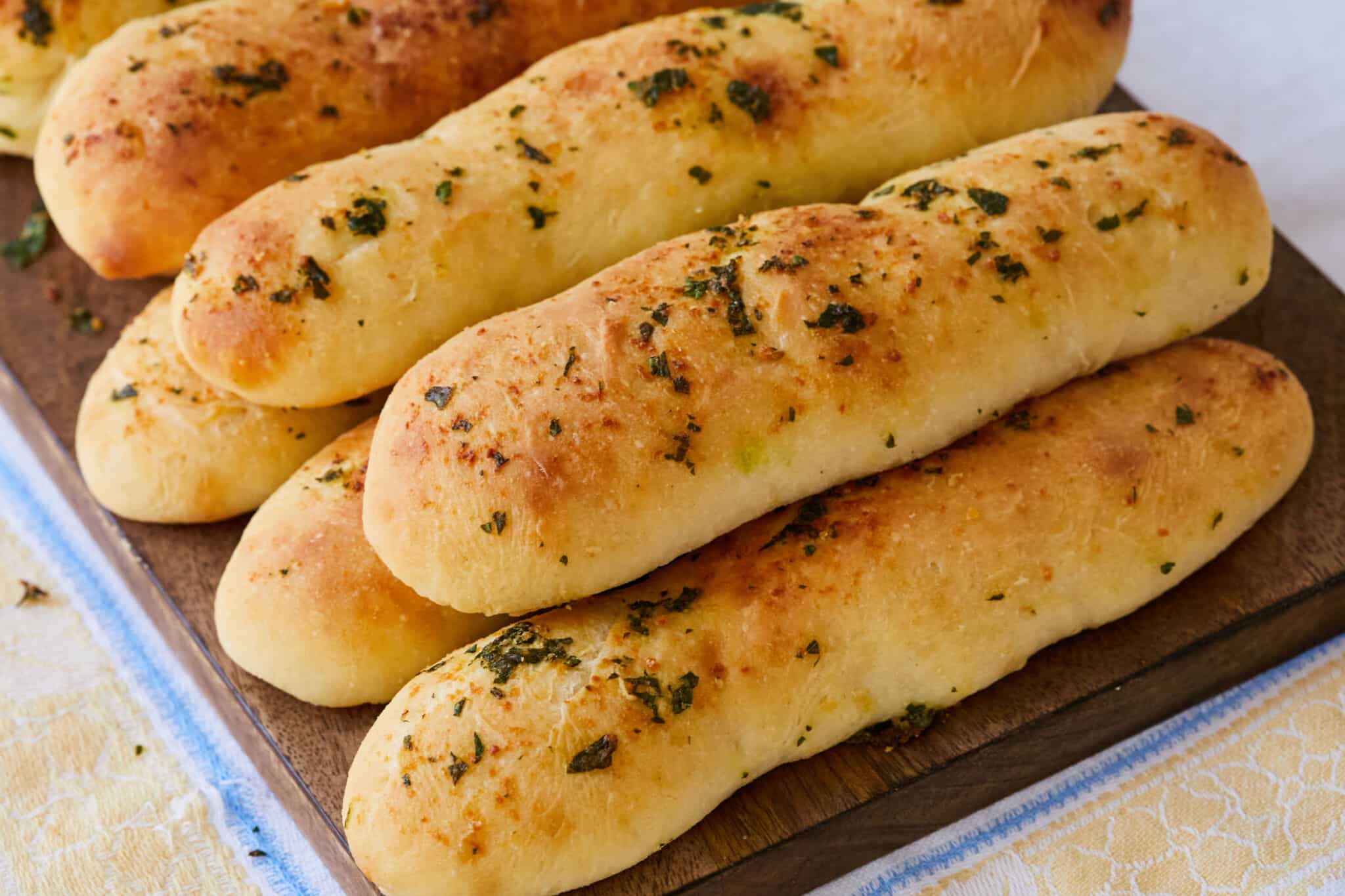
This post may contain affiliate links. Please see my full disclosure for details.
Hi Bold Bakers!
WHY YOU’LL LOVE THIS RECIPE: With this Garlic Breadsticks Recipe, you can easily whip up indulgent, buttery restaurant-level breadsticks that will have your kitchen smelling heavenly!
- These savory, soft dipping sticks elevate any meal, transforming weeknight dinner into a special occasion and making holiday meals extra memorable.
- Don’t let the yeast in this recipe scare you off! Garlic Breadsticks are easy to make, and I’ll guide you through each step. When you see how good it feels to put a basket of warm, golden-brown breadsticks on the table, you’ll want to have them in your regular rotation.
Garlic Breadsticks are versatile enough to accompany any meal, but of course, they’re a natural with an Italian dinner. Pasta has a special place in my heart, and I’ve shared with you over the years how easy it is to make your own delicious, fresh pasta. These garlicky homemade breadsticks are a lovely accompaniment to dishes like Homemade Penne Pasta, Farfalle Pasta, Orecchiette Pasta with marinara sauce, or The Best Lasagna Recipe.
Table of Contents
- What are Garlic Breadsticks?
- Tools You Need to Make Garlic Breadsticks
- Key Ingredients and Why
- How to Make Garlic Breadsticks
- Can I Make Garlic Breadsticks in Advance?
- How to Store Garlic Breadsticks
- FAQs
- Gemma’s Pro Chef Tips
- More Breadstick and Roll Recipes
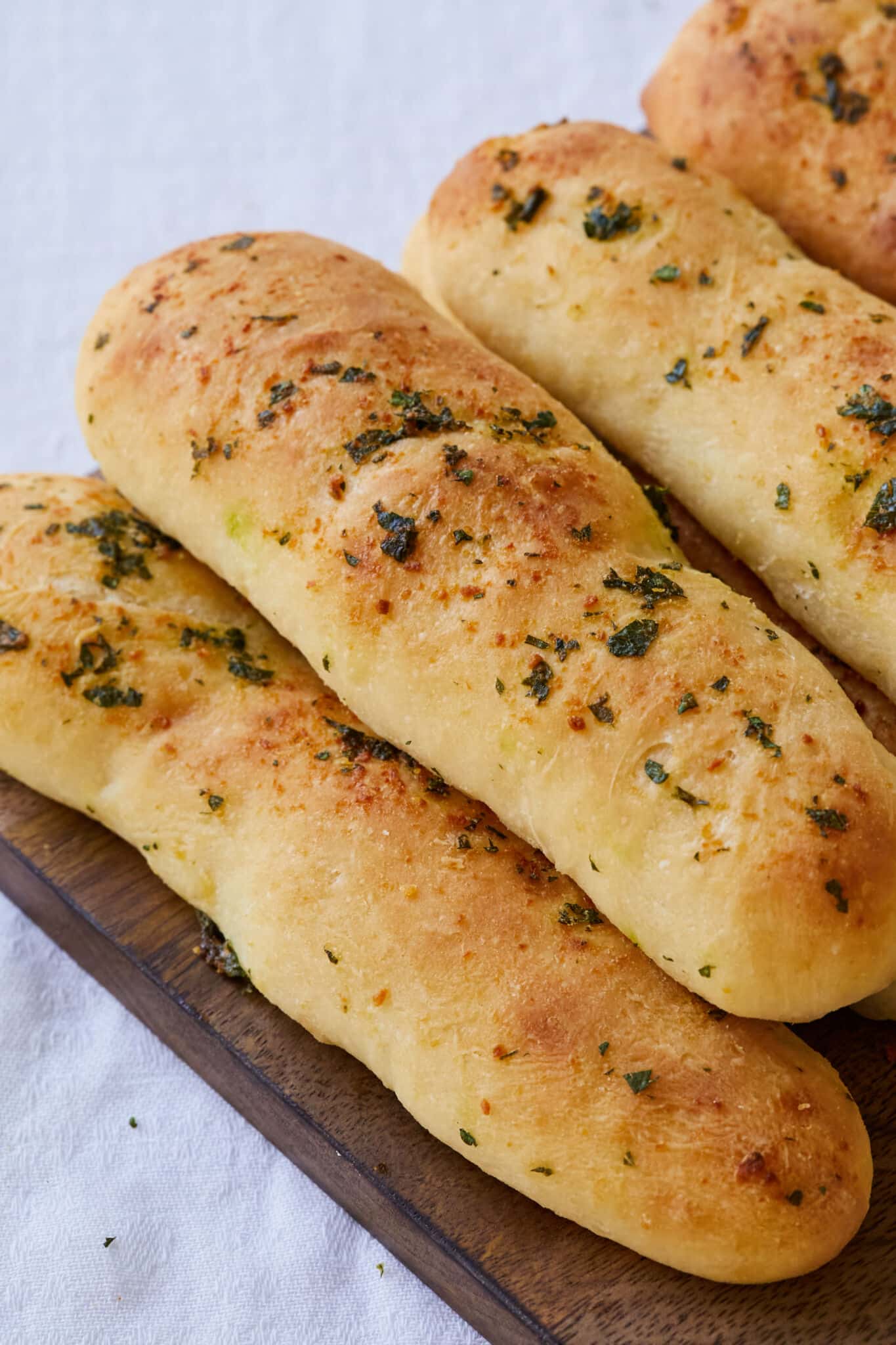
What are Garlic Breadsticks?
- These Garlic Breadsticks are bread made from yeast dough and shaped into elongated rolls. They’re brushed with melted butter mixed with garlic and parsley, and baked until golden brown.
- Since this Garlic Breadsticks are leavened with yeast, they have gluten strands. That makes them fluffy with a pleasant chewiness and a slightly crispy crust. In contrast, my 3-Ingredient Breadsticks Recipe (No Yeast) is leavened with baking powder and has a finer crumb. See FAQs below to find out why.
- Garlic bread originated in ancient Rome, and those early versions evolved into traditional Italian bruschetta. Garlic bread’s popularity exploded in the mid-20th century when it became a staple in Italian-American restaurants and pizza parlors. Garlic breadsticks, an individualized twist on garlic bread, are loved on their own and are the perfect bread for dipping in tomato sauce!
Tools You Need to Make Garlic Breadsticks
- Two baking sheets and parchment paper
- Stand mixer with a dough hook attachment
- Mixing bowls
- Measuring cups and measuring spoons
- Tea towels
- Pastry brush
Key Ingredients and Why
-
All-purpose flour
- All-purpose flour has a 9-11% protein content, perfect for making pleasantly soft breadsticks with a slight chewiness.
-
Granulated sugar
- Sugar feeds yeast, converting it into gas, making the dough rise and making the breadsticks light and airy.
- Sugar helps to retain moisture in the dough, ensuring a tender crumb.
- In addition, sugar is an element of the Maillard Reaction that contributes to the browning of the crust.
-
Instant yeast
- Instant yeast does not require sponging and gives a quicker, more efficient rise than active dry yeast.
- Mix instant yeast with flour first to avoid direct contact with salt so the yeast won’t get deactivated.
- If you use active dry yeast: for every teaspoon of instant yeast, use 1 ¼ teaspoons of active dry yeast. Bring the liquid in your recipe to blood temperature and mix in active dry yeast. Let it sit at room temperature for roughly 5 minutes until foam forms on top.
-
Salt
- Salt enhances the breadsticks’ flavor and strengthens the gluten, giving breadsticks the perfect chew.
- Salt also relaxes the dough so that it’s easier to shape.
-
Olive oil
- Olive oil also contributes to the texture of breadsticks, giving them a tender, moist crumb.
- Olive oil gives the breadsticks fruity and peppery notes.
- It allows for steam and carbon dioxide created during mixing, kneading, and fermentation to be trapped in the batter as it is baked, which causes the bread to rise more.
-
Salted butter
- Melted salted butter brushed on the breadsticks permeates them with savory flavor, and its richness perfectly balances the garlic’s boldness.
- The butter also works on the exterior of the dough to create a delectably crispy crust and a lovely sheen.
- Did you know it’s easy to make your own butter? How to Make Homemade Butter guides you through the process.
-
Garlic
- Garlic elevates this recipe with its robust, zingy, aromatic taste and aroma.
- Because it’s combined with melted butter in this recipe, the garlic is slightly mellowed and takes on a subtle sweetness.
-
Parsley
- Parsley adds a bright, herbaceous note and an appealing, colorful touch.
How to Make Garlic Breadsticks
- Prepare two baking sheets lined with parchment paper and oil in a large mixing bowl.
- Mix the dry ingredients including flour, salt, sugar, and yeast in the bowl of a stand mixer fitted with a dough hook.
- Add wet ingredients including olive oil and water to the dry ingredients. Knead on medium speed for 10 minutes until smooth and elastic.
- Proof the dough covered for 1 1/2 hours or until doubled in size.
- Shape the dough by punching the dough down and dividing it into 14 balls. Roll them into logs, place them on prepared baking sheets, and cover them with a damp, clean kitchen towel. Let rise for 40 minutes.
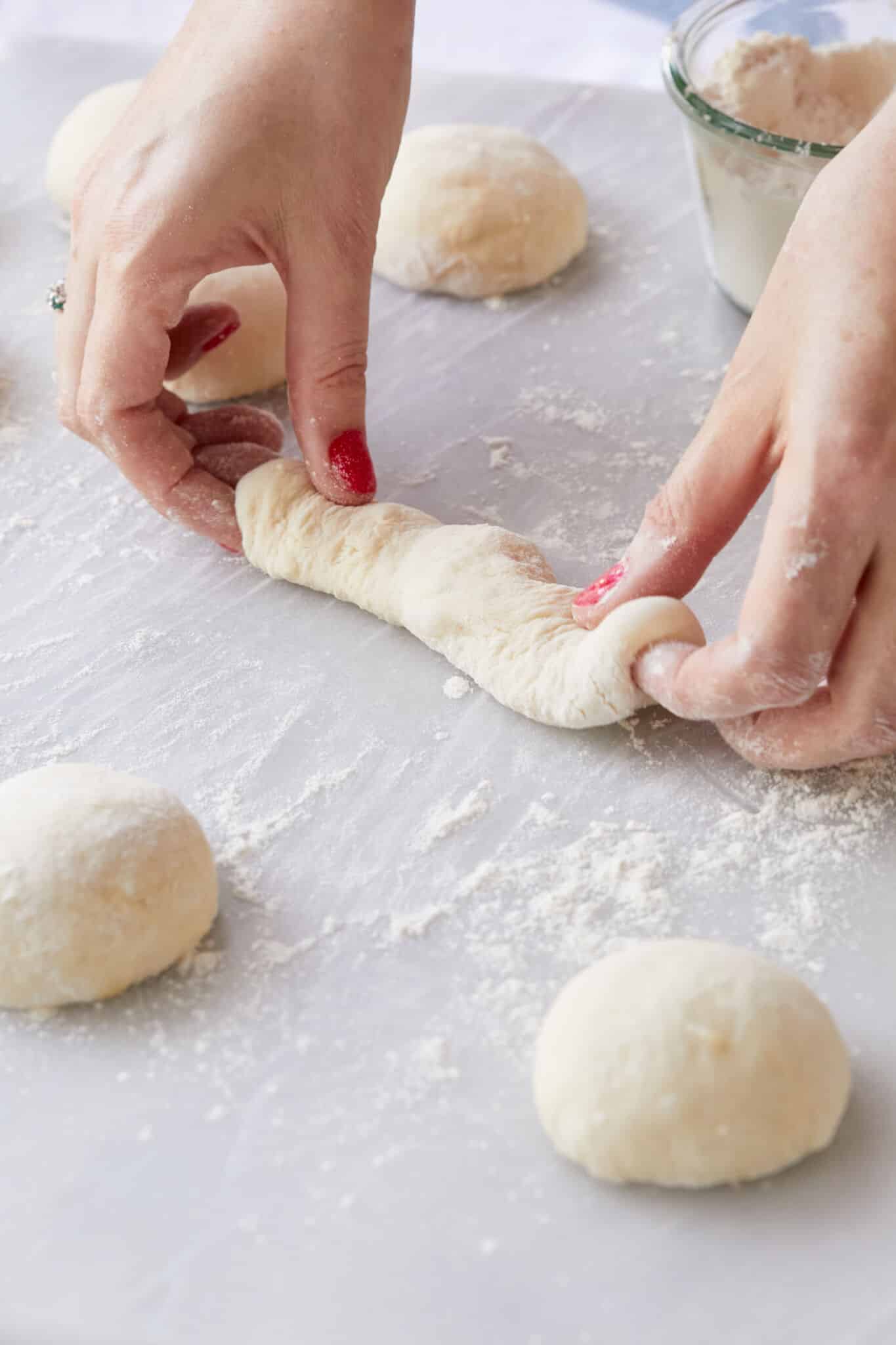
- Bake the breadsticks: Combine melted butter, garlic, and parsley. When the dough has doubled in size, brush with half of the butter mixture. Bake at 375°F (190°C) for 25 minutes, until golden brown. Brush with the remaining butter mixture.
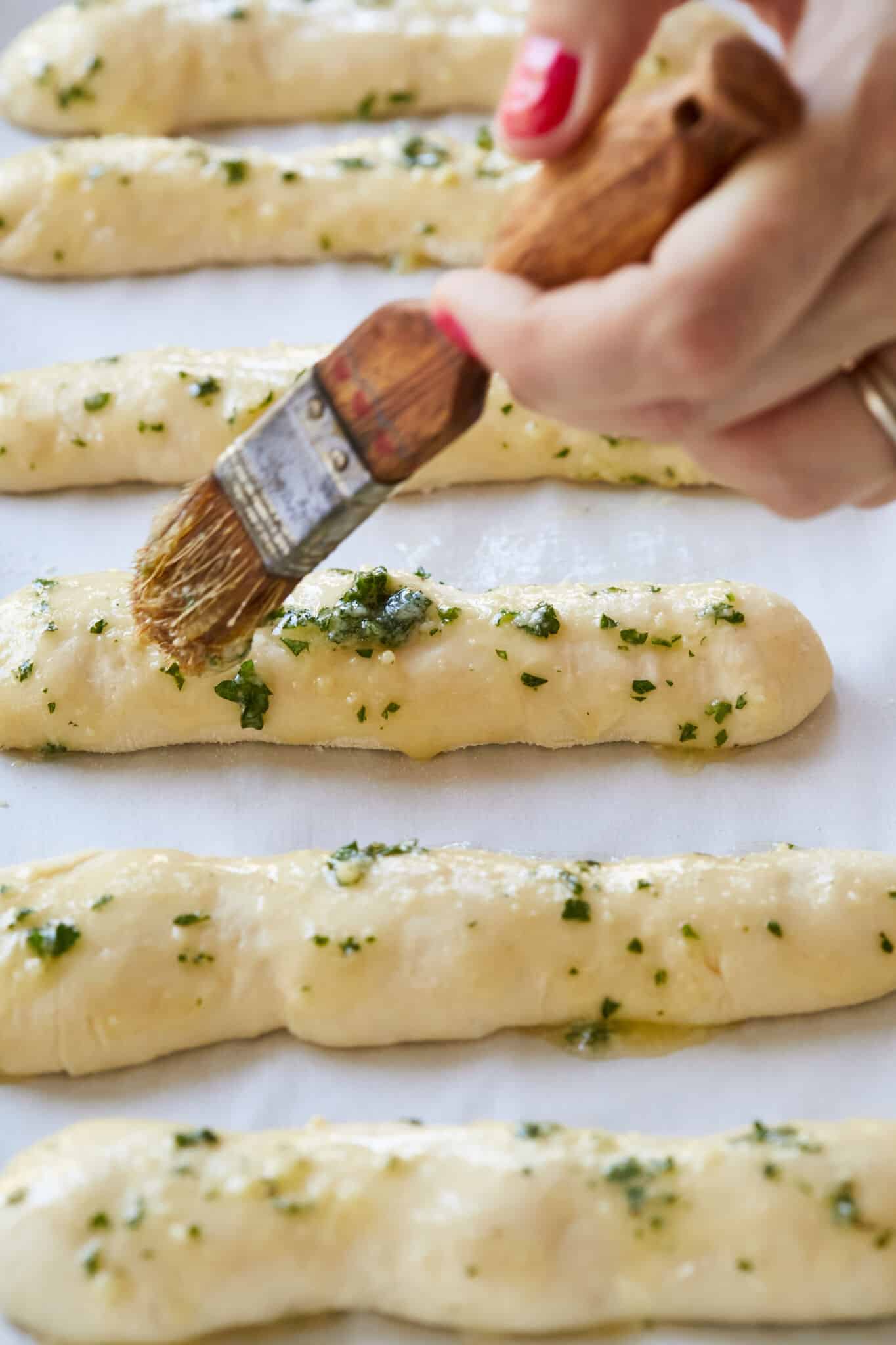
Can I Make Garlic Breadsticks in Advance?
Yes, you can make Garlic Bread in advance.
- To store in the fridge:
- Storing the unbaked breadsticks in the refrigerator will slow the rise.
- After the first rise, portion the dough, shape it into breadsticks and put them in the fridge for up to one day.
- Note not to over-proof the breadsticks. If they more than double in size, you must take them out and bake them off.
- To store in the freezer:
- You can bake the breadsticks and freeze them or portion the dough and freeze it before baking.
- After the first rise, shape the dough into sticks and put them into oiled freezer bags. Seal the bags well and freeze for up to four weeks.
- When you’re ready to bake your breadsticks, remove them from the bags and let them defrost slightly for about 15 minutes.
- Cover the pieces of dough with a tea towel and let them rise until they have doubled in size and a finger indent doesn’t spring back immediately. Then brush with garlic butter and bake as directed.
How to Store Garlic Breadsticks
- Store the breadsticks in an airtight container at room temperature for up to three days.
- If you have leftover breadsticks, then wrap them and freeze them for up to 8 weeks.
FAQs
-
What’s the difference between breadsticks made with yeast and those made without yeast?
- In this Garlic Breadsticks recipe, yeast works through a slow, natural, biological reaction by feeding on the sugars to release carbon dioxide that makes bread rise.
- During this slow fermentation process, with every burst of carbon dioxide that the yeast releases into an air bubble, protein, and water molecules move about to have another chance to connect and form more gluten.
- Kneading also causes protein and water to bond, forming gluten, a stretchy protein strand network that gives bread its structure.
- In a recipe such as 3-Ingredient Breadsticks Recipe (No Yeast), the baking powder works through a quick acid-base chemical reaction. Once baking powder is mixed with liquid, carbon dioxide is immediately released to make the baked goods rise.
- In this Garlic Breadsticks recipe, yeast works through a slow, natural, biological reaction by feeding on the sugars to release carbon dioxide that makes bread rise.
-
My dough is very sticky! What should I do?
- Be sure you’re kneading the dough for the recommended time. Kneading forms gluten, which absorbs some of the excessive moisture.
- When the dough is over-hydrated, the gluten networks can’t develop properly. Only add enough of the liquid until your dough forms a ball and the bowl is clean. Depending on your flour and location, you might need less—or a bit more—water to get the desired smooth and elastic consistency.
-
Why didn’t my breadsticks rise?
Certain things can affect the rise:
-
- If your dough didn’t rise, check whether your yeast is expired. Also, storing it in the fridge or freezer will keep it fresh longer.
- Salt does retard yeast growth, and in concentrations that are too high, it can kill the yeast. Keep salt and yeast separate, or mix each with flour first.
- If your dough was super wet and only had tiny bubbles, it was over-hydrated. The gluten networks can’t develop properly due to too much water incorporated. Flours don’t absorb liquid the same, so only use three-quarters of the recommended amount of liquid at first, and then add more gradually until the dough is smooth and elastic, as noted in the recipe.
- If your dough was too dry, the gluten networks would be too hard or not elastic enough to rise. Different flours don’t absorb liquids at the same rate, and you need more liquid.
- Do not over-proof or under-proof the dough. The telltale sign you use is how your dough looks: if the dough has doubled in size, almost feels lighter but still strong and a finger indent doesn’t spring back right away, then it’s ready.
- The more you shape your dough, the more tension it’s receiving, which means the longer time the dough needs to rest enough for a better rise
-
Can I substitute another flour in this recipe?
- You can use bread flour in this recipe, but the breadsticks won’t be as soft as those made with all-purpose flour. Since bread flour has more protein, you may need to use more liquid. Add a tablespoon at a time until the desired smooth and elastic consistency.
- If you prefer whole wheat, I don’t suggest you use more than 50% whole wheat flour. If you use more, you may end up with heavy or dense breadsticks.
-
How can I make gluten-free breadsticks?
- This yeast-bread recipe relies on gluten formation, so it’s unsuitable for gluten-free diets.
- Please try my quick and delicious 3-ingredient Breadsticks (No Yeast) recipe instead.
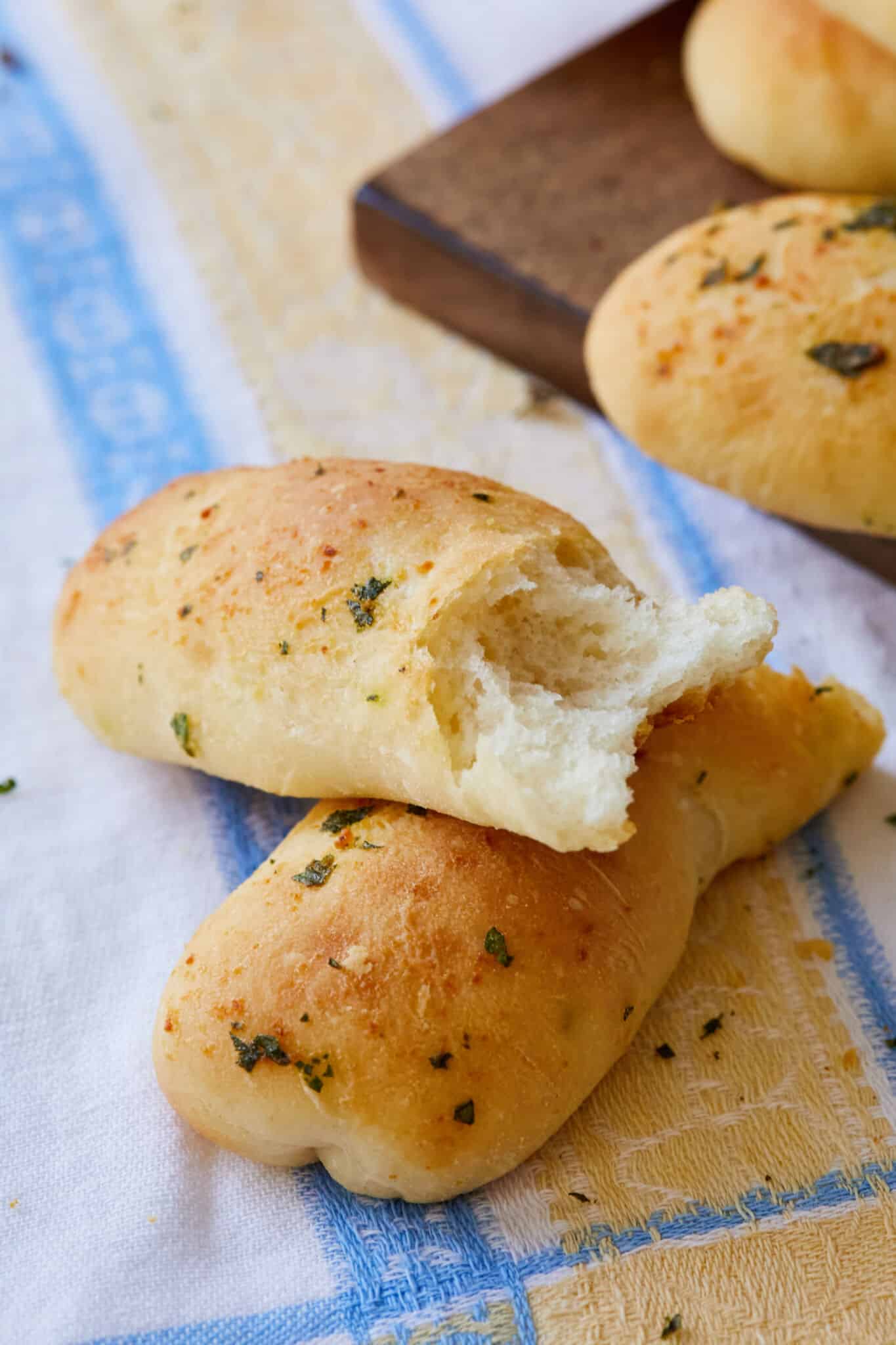
Gemma’s Pro Chef Tips
- Lukewarm water is essential when working with yeast. Heat it in the microwave for a few seconds until it is slightly warm to the touch.
- I use instant yeast, but if you prefer to use active yeast, then just use 2 1/2 teaspoons of active yeast and make sure to sponge it in the liquid
- You can knead this dough by hand for about 8 minutes if you don’t have a stand mixer.
- Feel free to add any savory spices or even add grated Parmesan cheese into the flour or sprinkle on top for more flavor.
- These are great as a side dish with salad and soup like Homemade Microwave Chicken Ramen in a Mug or The Easiest Potato Soup Recipe.
More Breadstick and Roll Recipes
- Soft and Fluffy Pumpkin Dinner Rolls
- Sage and Cheddar Biscuits (No Yeast)
- Buttery Crescent Rolls from Scratch
- How to Make Waterford Blaas (Authentic Irish Rolls Recipe)
- Pepperoni Pizza Rolls
Garlic Breadsticks Recipe
Ingredients
- 3 ½ cups (17½ oz/497 g) all-purpose flour
- 1 tablespoon granulated sugar
- 2 teaspoons instant yeast
- 1 ½ teaspoons salt
- 1 ¾ cups (14 fl oz/420 ml) lukewarm water
- 2 tablespoons olive oil
- ¼ cup (2 oz/57 g) salted butter, melted
- 2 large cloves of garlic, crushed
- 2 tablespoons finely chopped parsley
Instructions
Make the Dough
- Line two baking sheets with parchment paper and set aside.
- In the bowl of a stand mixer fitted with a dough hook, combine the flour, sugar, yeast and salt.
- Add the warm water and olive oil and knead on medium speed for 10 minutes.
- Transfer the dough to an oiled bowl, turn the dough to coat in oil, cover with plastic wrap and let rise in a warm place until doubled in size, about 1 ½ hours.
- Once risen, punch the dough down and divide into 14 balls.
- On a floured surface, roll each ball into a 6” (15 cm) log and place on the prepared baking sheets.
- Cover with clean, damp tea towels and let rise until doubled in size, about 40 minutes.
Make the Garlic Butter
- While the dough is rising again, in a small bowl, combine the melted butter, garlic and parsley. Set aside.
- When the dough has almost risen, preheat the oven to 375°F (190°C).
- Once the dough is ready, brush with half of the garlic butter and bake for about 25 minutes, or until golden brown.
- Remove from the oven and brush with the remaining garlic butter. Serve while still warm.
- Store leftovers in an airtight container for up to 3 days.
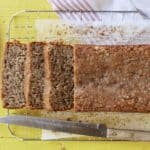
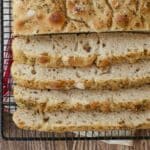
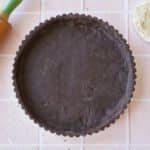

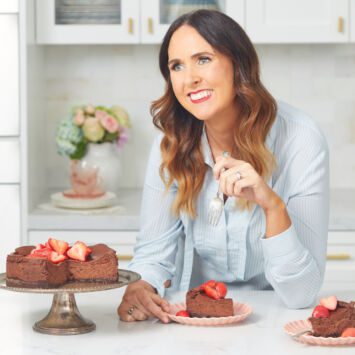

flour is impossible to get where I am, could I use oats and what quantity?